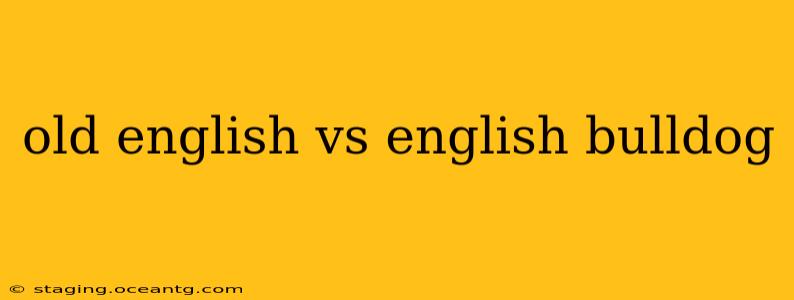The Old English Bulldog and the English Bulldog, while sharing a name and a lineage, are distinctly different breeds. Understanding these differences is crucial for anyone considering either breed, as their temperaments, health needs, and overall care requirements vary significantly. This comprehensive comparison will explore the key distinctions between these two fascinating breeds.
What are the Key Differences Between Old English Bulldogs and English Bulldogs?
The most significant differences lie in their physical appearance, temperament, and health. The modern English Bulldog, while retaining some of its ancestral fighting dog traits, has been selectively bred for its distinctive, somewhat comical appearance. The Old English Bulldog, on the other hand, strives to retain more of the original breed's athleticism and functionality.
Physical Appearance: Size, Structure, and Features
English Bulldog: The English Bulldog is characterized by its compact, low-slung body, a broad head with a pushed-in nose (brachycephalic), and a wrinkled face. They are significantly shorter and stockier than their Old English counterparts.
Old English Bulldog: Old English Bulldogs are larger and more muscular than English Bulldogs. They have a longer snout, less pronounced wrinkles, and a more athletic build, resembling a smaller, more agile version of a Bullmastiff. Their overall appearance is less extreme than the modern English Bulldog.
Temperament and Personality: Differences in Behavior
English Bulldog: English Bulldogs are known for their friendly, docile, and often comical personalities. They are generally good with children and other pets, but their brachycephalic features can make them prone to overheating and breathing problems, impacting their energy levels. They are usually happy to lounge around and be pampered.
Old English Bulldog: Old English Bulldogs are more energetic and athletic. While still friendly and loyal, they possess a more independent and sometimes stubborn streak. Their higher energy levels require more exercise and mental stimulation than their English Bulldog cousins. They're often described as more alert and watchful.
Health Considerations: Breed-Specific Issues
English Bulldog: Due to their extreme physical features, English Bulldogs are prone to numerous health problems. These include breathing difficulties (brachycephalic airway syndrome), skin folds infections, eye problems, and hip dysplasia. Their short snout also makes them susceptible to overheating and heatstroke.
Old English Bulldog: While still susceptible to some health issues common in Bulldogs, Old English Bulldogs generally have fewer health problems than their English counterparts. Their longer snout allows for better breathing, reducing the risks associated with brachycephalic airway syndrome. However, hip and elbow dysplasia, and certain eye conditions, can still be concerns.
What are the origins of the Old English Bulldog?
The Old English Bulldog is considered a more accurate representation of the original bull-baiting dogs of the 1800s. With bull-baiting outlawed, the breed's function shifted, and selective breeding led to the development of the modern English Bulldog, prioritizing looks over functionality. The Old English Bulldog attempts to recapture some of the athleticism and working abilities of the original breed.
How much exercise does an Old English Bulldog need?
Old English Bulldogs require significantly more exercise than English Bulldogs. Daily walks, playtime, and mental stimulation are crucial for their physical and mental well-being. Failing to provide adequate exercise can lead to behavioral issues and obesity.
What is the lifespan of an English Bulldog?
Both English and Old English Bulldogs have similar lifespans, typically ranging from 8 to 10 years. However, the health problems associated with brachycephaly in English Bulldogs can sometimes shorten their lives.
Which breed is right for me?
The choice between an Old English Bulldog and an English Bulldog depends entirely on your lifestyle and preferences. If you're looking for a low-energy companion who is happy to cuddle on the couch, an English Bulldog might be a good fit. However, if you are active and can provide plenty of exercise and mental stimulation, an Old English Bulldog might be a better choice. Remember to thoroughly research both breeds and consider your ability to provide appropriate care before making a decision. Consulting with breeders experienced in both breeds is also highly recommended.
